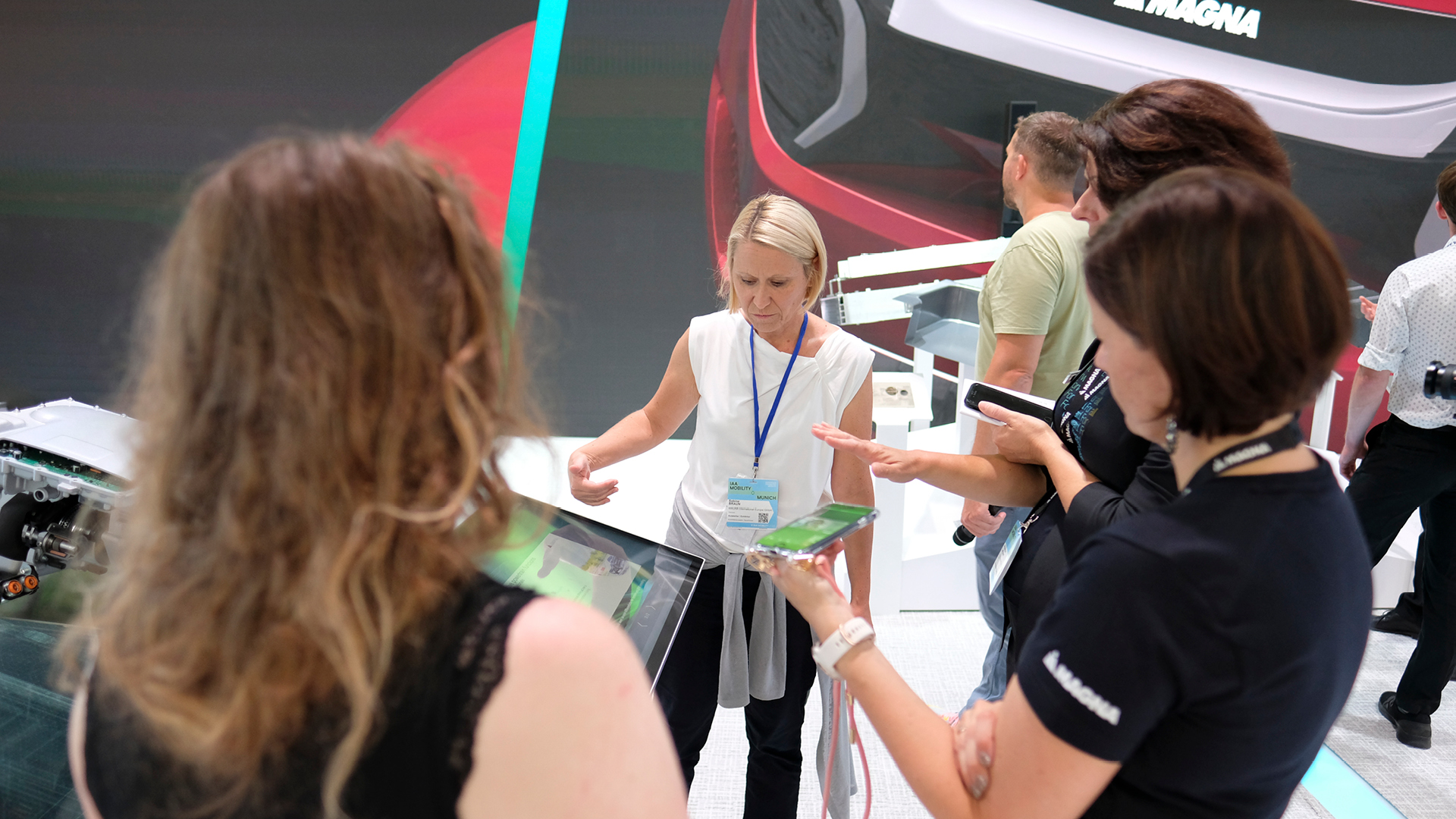

Especially at technology trade fairs, in showrooms and other branded spaces, interactive exhibits are magnets that attract and captivate visitors. But what makes a good exhibit, and what should you pay attention to during design and implementation? Find out from our two marketing and design experts Gerhard Preslmayer and Peter Thavonat why interactive exhibits are so popular and successful and how their use is worthwhile.
This interview, which is linked to the topic of trade fair design, takes a second look at the practice of exhibit design: Gerhard Preslmayer, CEO at SPS MARKETING, has been developing and accompanying the brand presentations of international companies at global trade fairs and exhibition rooms for over 40 years as a designer and strategist. Peter Thavonat, Art Director at SPS MARKETING, is a specialist in the construction of spaces and rooms and the design of 3D models at trade fairs. Both have not only created numerous interactive product presentations but have also supervised them on site – and know the challenges in application.
Gerhard Preslmayer: Interactive displays are not only tools for presenting information, but also powerful media format for communication, public relations and customer loyalty. With their appeal and the added value they create, they invite potential customers to actively participate and ensure that they stay longer in the exhibition area at a trade fair or in the showroom. Additionally, they generate valuable data and support lead generation by providing contact information in exchange for further content..

Peter Thavonat: Interactive exhibits are the ultimate tools for creating memorable product experiences and generating attention. They offer a unique opportunity to make complex technical products and services understandable and tangible for potential customers. Furthermore, they provide the opportunity for potential customers to engage in a relevant dialogue with experts. By using extraordinary exhibits, companies can create unforgettable “aha” moments and increase their brand awareness. This fosters trust in the company and supports the purchase decision-making process.
“Visual anchor points with enormous appeal!”
Gerhard: One advantage of digital exhibits is that, as visual anchor points, they have offer enormous added value, even beyond the exhibition area. The object design plays a crucial role: When implementing the functions, we as designers are tasked with make them inviting. A display can be simply installed in the room or staged in an exciting “package” - which clearly increases the experience factor. The combination of different communication channels such as audio, motion design, tactile objects or sensory components enables different senses to be addressed. This can also work in a playful way but should always be product-relevant.
Peter: The functionality also has a significant influence on its attractiveness. Particularly when various systems in products of processes interact with each other and are not visible, we can make content tangible through simulations or reproduction of functions and deliver several pieces of content at the same time. We use supervised or unsupervised exhibits - depending on the complexity of the content and the audience's prior knowledge. Basically, content should be prepared in an easy-to-understand manner. We can make background information available optionally.
“Experience a product emotionally – haptically and multisensorily.”
Gerhard: Futhermore, we aim to transport this content into the virtual world even without exhibits or haptics. For sustainable use, we distill content, make it available as website content, create derivatives and establish connections so that the content continues to work. This means that the investments for an exhibit can be assessed in a different light.
Peter: User experience comes first here. Navigation must be clear, and operation should be as intuitive as possible. Nobody should be overwhelmed. Physical characteristics and responsiveness play crucial roles. They help exhibits impress not only by looking cool but also with pleasant haptics. This enables a product to be explored and experienced without disturbances. For security reasons, a solid construction is important, and the software must also run stably and securely. Regardless of the principle the exhibit is based on – whether AR, VR, mechatronic or purely digital – it must work offline. Only maintenance and the ability to update content should be provided online.
Gerhard: Exhibits that offer a real product experience and give feedback to the audience on their activity are popular: these can be haptic elements, products or results. For Magna Powertrain, for example, we developed a digital configurator that generates the ideal drive system for different types of drivers by using different parameters entered by users. Large-format exhibits such as the plastic injection molding machine that we staged for the Rico Group at the K trade fair in Düsseldorf arouse curiosity. In this case, plastic boxes were produced live, which we anchored in the story of the communication concept: trade fair invitations included silicone inlays, and the corresponding plastic box was available at the stand. Linking content with the real product experience worked very well - visitors queued in long lines.
“Interactions anchor content more firmly in memory!”
Peter: Our client Magna is one of the largest automotive suppliers in the world. For the IAA 2023 in Munich we developed a series of interactive displays to show different drive systems and how they work based on different requirements. This included topics such as automated driving, which could be experienced in an application-oriented manner through the combination of real products, product animations and tech sheets. We implemented this using large monitors installed in a sleek object and controlled in a network. Interested parties could start various driving situations and at the same time see how the real components in the vehicle interact with each other. Supplemented with product animations for even more “deep dive” content – a variety of complex content that, thanks to interactive displays, has a multisensory effect in an exclusive product experience.
Gerhard: The data generated in the exhibit shows exactly which detailed content was of greatest interest and allows conclusions to be drawn about relevance and effectiveness. For example, it can be determined how many visitors were interested in which exhibit and how long they engaged with it. Data analysis provides clear traceability and offers extensive opportunities for knowledge-based optimization. For the investment in well thought-out presentations to be successful, the measurability of the measures is essential.
At every touchpoint of an exhibit, the rule is: If you want to be remembered, seek interaction! An interactive display stands out through good object design and relevant information, connecting brand, product and solution to create a sustainable brand and product experience for customers, interested parties and opinion leaders. This helps to convey products that require explanation. Ideally, a good exhibit should meet the criteria of interactivity and engagement, personalization and relevance, as well as infotainment and entertainment.
Do you want to use interactive displays as powerful media for your communication? Keep an eye on current developments – our experts will introduce you to the latest trends and innovations.
